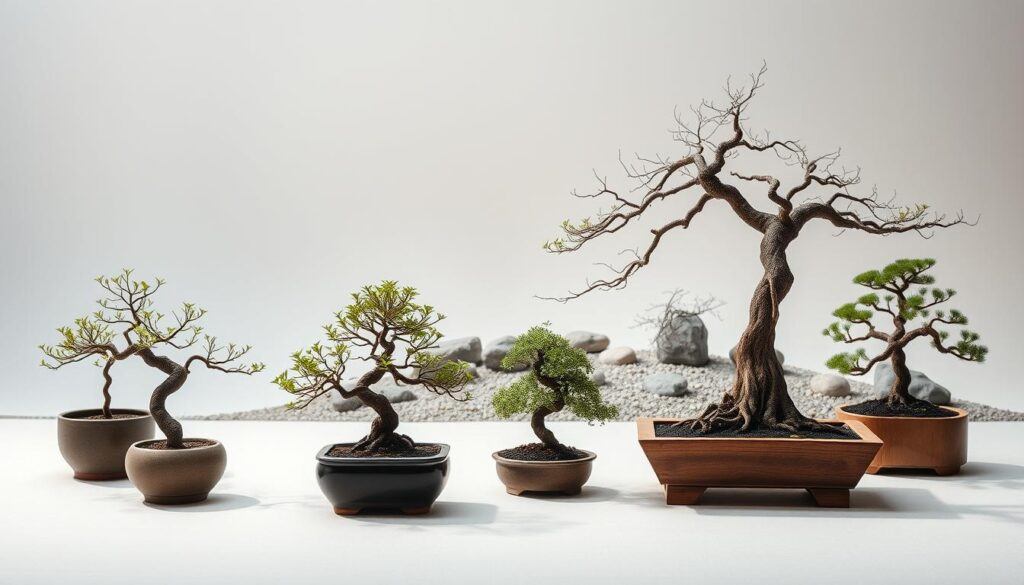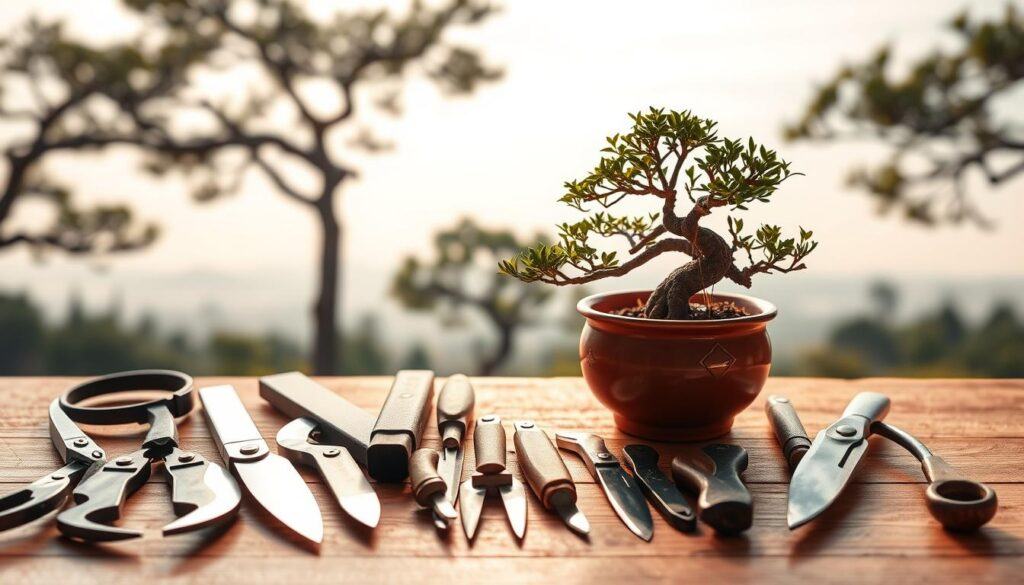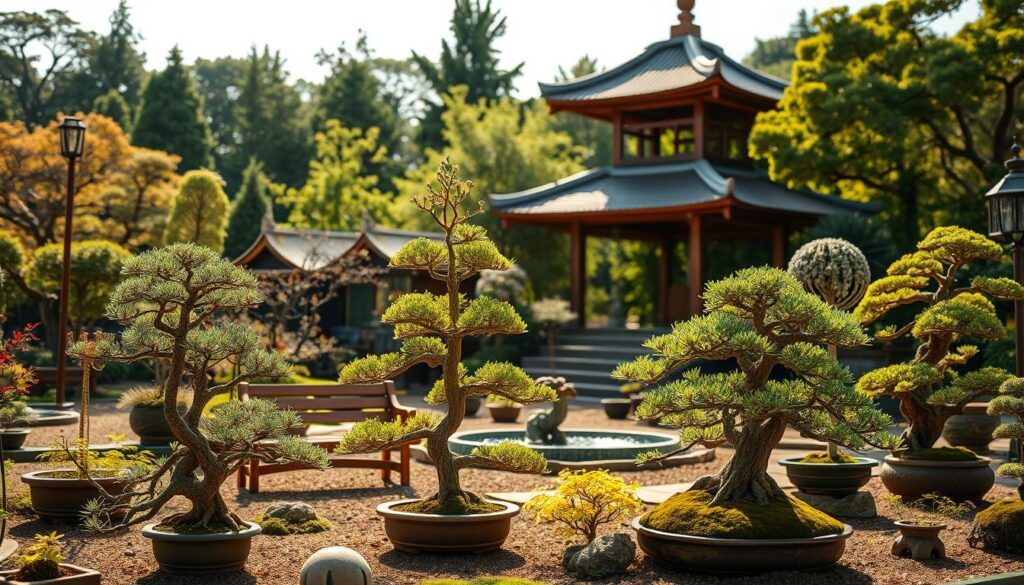Growing bonsai trees can be a fascinating hobby, but for beginners, the specialized language used can be overwhelming.
Understanding the fundamental terms is crucial for anyone looking to start their bonsai journey. This article aims to introduce beginners to the essential concepts they need to know.
From the meaning of the art itself to the various techniques and tools used, we will cover the foundational knowledge required to appreciate and care for these beautiful trees.
Key Takeaways
- Understanding key terms used in bonsai cultivation
- Learning the fundamental concepts of bonsai care
- Familiarizing yourself with common bonsai techniques
- Discovering the tools needed for bonsai maintenance
- Gaining confidence in caring for your bonsai tree
The Fascinating World of Bonsai
The art of bonsai has captivated enthusiasts worldwide with its intricate beauty and rich history. Bonsai cultivation is not just a hobby; it’s a journey into a world where nature, art, and patience converge.
Origins and Cultural Significance
Bonsai originated in ancient China and was later refined in Japan, evolving into distinct styles and techniques. The art form is deeply rooted in Eastern cultures, reflecting philosophies such as Zen Buddhism and the concept of Wabi-Sabi, which appreciates the beauty of imperfection.
Japanese vs. Chinese Traditions
While both Japanese and Chinese bonsai share common roots, they have developed unique characteristics over time. Japanese bonsai tends to emphasize simplicity and minimalism, whereas Chinese bonsai often incorporates more elaborate designs and symbolism.
As John Naka, a renowned bonsai master, once said, “Bonsai is not just a plant, it’s a work of art that requires patience, dedication, and a deep understanding of nature.” This quote encapsulates the essence of bonsai cultivation, highlighting its artistic and cultural dimensions.
“The art of bonsai is not just about growing trees; it’s about capturing the essence of nature in a small, controlled environment.”
Why Learning Terminology Enhances Your Bonsai Journey
Understanding bonsai tree terminology is crucial for appreciating the art form fully. It allows enthusiasts to communicate effectively and gain insights into the techniques and principles guiding bonsai cultivation.
Essential Basic Bonsai Terminology
To truly appreciate the art of bonsai, one must first understand its fundamental terms. The terminology used in bonsai is a blend of traditional Japanese and modern Western terms, reflecting the global nature of this ancient art form.
What “Bonsai” Actually Means
The term “bonsai” itself refers to the art of growing trees in containers, training them to achieve a desired shape or style through meticulous pruning and care. This definition encompasses not just the trees, but the entire process and philosophy behind bonsai cultivation.
Fundamental Japanese Terms Used Globally
Many terms used in bonsai are derived from Japanese, highlighting the country’s significant influence on the global bonsai community. Terms like “shin” (trunk) and “eda” (branch) are used worldwide.
- Shin: Refers to the main trunk of the bonsai tree.
- Eda: Denotes the branches of the bonsai.
Pronunciation Guide for Beginners
Pronunciation is an important aspect, as it connects practitioners to the heritage of bonsai. For beginners, a pronunciation guide can be very helpful. For example, “bonsai” is pronounced as “bone-sigh.”
Western Terms That Have Entered the Lexicon
In addition to Japanese terms, Western terminology has also been incorporated into the bonsai lexicon, reflecting the global spread of the hobby. Terms related to styling and care have been adopted from Western horticulture, enriching the vocabulary of bonsai enthusiasts worldwide.
Tree Anatomy Terms You Need to Know
The art of bonsai cultivation relies heavily on knowledge of tree anatomy. Understanding the various parts of a bonsai tree is crucial for its care and styling.
Root System Vocabulary
The root system of a bonsai tree is vital for its overall health. Terms like nebari refer to the visible roots that spread out from the base of the trunk, creating a visually appealing effect. Nebari is a key element in bonsai aesthetics, as it adds character to the tree.
Another important term is taproots, which are the main roots that grow straight down into the soil. Understanding taproots is essential for proper bonsai care, as they play a critical role in the tree’s stability and nutrient uptake.
Trunk and Branch Terms
The trunk and branches of a bonsai tree have their own set of terminology. Jin refers to the deadwood on a branch, while shari refers to the deadwood on the trunk. These terms are important for creating the desired shape and style in a bonsai tree.
Foliage and Growth Point Terminology
Foliage and growth points are critical areas of a bonsai tree. Understanding terms like node (the point on a stem where a leaf meets the stem) and internode (the section of stem between two nodes) is essential for pruning and training.
Understanding Nodes and Internodes
Nodes and internodes are fundamental concepts in bonsai care. By understanding these terms, enthusiasts can better manage the growth and shape of their bonsai trees. Proper pruning techniques rely on identifying nodes and internodes to achieve the desired shape and promote healthy growth.
Bonsai Styling and Design Language
Creating a bonsai involves a harmonious blend of horticultural skill and artistic vision, guided by specific styling principles. The art of bonsai is not just about shaping a tree; it’s about understanding the language that describes its beauty and character.
Classical Style Names and Their Meanings
Bonsai has a rich vocabulary of classical styles, each with its unique characteristics and historical significance. Understanding these styles is crucial for appreciating the nuances of bonsai design.
Formal Upright to Windswept Styles
Styles like Chokkan (Formal Upright) and Fukinagashi (Windswept) are among the many classical forms that bonsai trees can be shaped into. Each style has its distinct features and challenges.
Design Element Vocabulary
Key elements in bonsai design include the trunk, branches, and foliage. Terms like Nebari (root flare) and Jin (deadwood) are essential for describing and shaping a bonsai.
| Bonsai Style | Description |
|---|---|
| Chokkan | Formal Upright style, characterized by a straight, vertical trunk. |
| Fukinagashi | Windswept style, where branches are shaped to convey the effect of wind. |
Aesthetic Concepts
Aesthetic concepts like Wabi-Sabi (acceptance of transience) and Ma (the space between things) play a significant role in bonsai appreciation, emphasizing the importance of subtlety and restraint in design.

Care and Maintenance Terms Decoded
To keep your bonsai thriving, it’s essential to familiarize yourself with the language of bonsai care. The terminology associated with the daily upkeep and long-term health of bonsai trees is as fascinating as it is necessary.
Pruning and Pinching Terminology
Pruning and pinching are critical techniques in bonsai cultivation, each with its own specific terminology. Structural pruning refers to the significant cuts made to shape the tree, while maintenance pruning involves regular trimming to maintain the tree’s shape and promote healthy growth.
Difference Between Structural and Maintenance Pruning
Understanding the difference between structural and maintenance pruning is vital. Structural pruning is typically done during the tree’s dormant season and involves major cuts to alter the tree’s structure. Maintenance pruning, on the other hand, is an ongoing process that ensures the tree retains its desired form and continues to thrive.
Watering and Feeding Vocabulary
Watering and feeding are crucial for the health of your bonsai. Terms like hydration and fertilization are key to understanding how to keep your bonsai nourished. The frequency and method of watering and feeding vary depending on the species, climate, and time of year.
Seasonal Care Terms Every Beginner Should Know
Seasonal care involves adjusting your bonsai care routine according to the time of year. Terms like dormancy and repotting are essential to understand as they relate to the seasonal needs of your bonsai. For example, many bonsai trees require repotting in the spring to refresh the soil and prune the roots.
Tools of the Trade: Bonsai Equipment Glossary
Bonsai cultivation is an art that relies heavily on the right equipment, from cutting and shaping tools to wiring and training gear. Understanding the terminology associated with these tools is essential for any bonsai enthusiast looking to improve their skills.
Essential Cutting and Shaping Tools
Cutting and shaping are fundamental aspects of bonsai care, requiring precision and the right tools. Concave cutters and knob cutters are among the most critical tools in this category.
Concave Cutters vs. Knob Cutters
Concave cutters are designed to remove branches without leaving a visible stump, promoting a cleaner healing process. In contrast, knob cutters are used to remove larger branches, leaving a small knob that can be further refined. Understanding when to use each is crucial for effective pruning.
Wiring and Training Equipment Terms
Wiring is a technique used to shape the bonsai tree, requiring specific types of wire and an understanding of how to apply it without damaging the tree. Terms like aluminium wire and annealed wire are commonly used in this context.
Potting and Maintenance Tool Vocabulary
Repotting and maintenance are critical for the health of a bonsai tree. Tools such as chopsticks for gently removing old soil and soil sieves for preparing new soil are indispensable. Familiarity with these tools and their uses is vital for bonsai care.

Container and Growing Medium Terminology
Understanding the terminology related to bonsai containers and growing mediums is crucial for any bonsai enthusiast. The container and growing medium play a vital role in bonsai care, with specific terms that describe their characteristics and functions.
Bonsai Pot Types and Their Traditional Names
Bonsai pots come in various shapes, sizes, and materials, each with its traditional name reflecting its style and origin. For instance, pots can be categorized into different styles such as rectangular, oval, or round, and are made from materials like ceramic or clay. The choice of pot can significantly impact the aesthetic appeal of the bonsai tree.
Soil Component Vocabulary
The soil used for bonsai trees is specialized, with components that provide the necessary drainage and nutrients. Key components include akadama, pumice, and lava rock.
Understanding Akadama, Pumice, and Lava Rock
Akadama is a type of clay granule that retains moisture while allowing for good drainage. Pumice is used to improve soil structure and increase drainage. Lava rock, on the other hand, adds porosity to the soil and helps with root aeration. Understanding the roles of these components can help in selecting the right soil mix for your bonsai.
Drainage and Root Health Terms
Terms related to drainage and root health are vital in bonsai care. Proper drainage is essential to prevent waterlogged soil, which can lead to root rot. Understanding these terms can help bonsai enthusiasts better care for their trees, ensuring healthy root development and overall tree well-being.
Conclusion: Growing Your Bonsai Knowledge
As you embark on your bonsai journey, understanding basic bonsai terminology is a crucial step. Familiarizing yourself with the language of bonsai anatomy, styling, care, and equipment enhances your appreciation and improves your care of these miniature trees. With a solid foundation in bonsai for beginners, you can deepen your understanding and enjoyment of this rewarding hobby.
Mastering basic bonsai terminology opens the door to a lifelong path of learning and discovery. As you continue to explore the fascinating world of bonsai, you’ll find that this knowledge enhances your skills and appreciation of the art form. Whether you’re just starting out or have already begun your bonsai journey, the world of bonsai awaits your exploration.
FAQ
What does "bonsai" actually mean?
“Bonsai” refers to the art of growing trees in containers, where the trees are trained to achieve a desired shape or style through careful pruning and care.
What are some essential Japanese terms used in bonsai?
Terms like “shin” (trunk), “eda” (branch), and “nebari” (visible roots) are commonly used in the bonsai community.
What is the difference between structural pruning and maintenance pruning?
Structural pruning involves major cuts to shape the tree, while maintenance pruning involves smaller, regular cuts to maintain the tree’s shape and promote healthy growth.
What is "wabi-sabi" and how does it relate to bonsai?
“Wabi-sabi” is an aesthetic concept that values the acceptance of transience and imperfection, often reflected in the subtle, natural beauty of a well-crafted bonsai.
What are some common bonsai pot types and their traditional names?
Traditional bonsai pots have names like “Kawase” and “Tenshin” that reflect their style and origin.
What is "akadama" and how is it used in bonsai soil?
“Akadama” is a type of clay soil component that is highly valued for its water-retentive properties and is often used in bonsai soil mixes.
How often should I water my bonsai tree?
The frequency of watering depends on factors like the tree species, climate, and soil mix, but it’s generally recommended to water when the top layer of soil feels dry to the touch.
What is the purpose of wiring in bonsai?
Wiring is used to shape and train the branches of a bonsai tree, allowing for the creation of intricate and balanced designs.
What are some key terms related to bonsai tree anatomy?
Terms like “node” (the point on a stem where a leaf meets the stem) and “internode” (the section of stem between two nodes) are essential for understanding bonsai tree anatomy.
